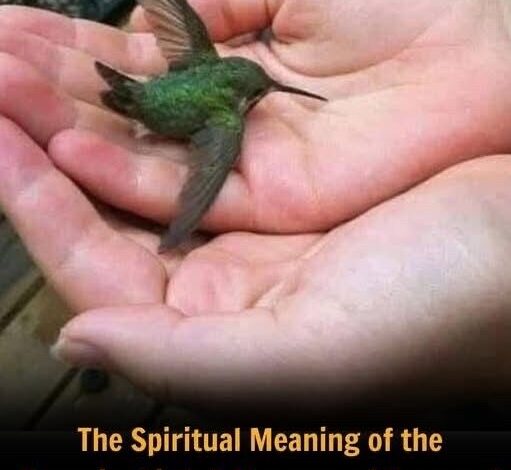
Did You Know That If a Hummingbird Comes to Your Home, It Means Something Special?
Hummingbirds have fascinated people for centuries. Their tiny frames, rapid wings, and dazzling colors make them seem almost otherworldly. Yet beyond their beauty, these birds carry a weight of symbolism that stretches across cultures, religions, and generations. For many, a hummingbird’s sudden appearance outside a window or in a garden is far more than a natural event. It is seen as a meaningful message—an omen of hope, joy, and even spiritual connection.
In Native American traditions, hummingbirds are considered sacred messengers of positivity. Some tribes believe they bring blessings to a home, carrying prosperity and harmony wherever they appear. Their fluttering energy is thought to cleanse heavy atmospheres, replacing worry with lightness and vitality. To see one is to be reminded that life is fleeting, yet full of beauty, and that joy can be found even in the smallest of moments.
These beliefs extend into other cultures as well. In Central and South America, hummingbirds have long been associated with renewal and resilience. Ancient Aztec legends spoke of fallen warriors returning to earth as hummingbirds, visiting the world of the living through flashes of iridescent wings. In this sense, the bird represents both continuity and transformation: death giving way to life, and despair giving way to hope.
The idea that hummingbirds bring good fortune remains alive today. Many people interpret a visit from one of these birds as a sign that new opportunities are about to arrive. Whether it’s a job offer, a long-awaited reunion, or even a personal breakthrough, the sudden presence of a hummingbird feels like nature’s way of whispering, “Be ready—good things are coming.” The timing often feels uncanny. A person struggling with doubt or standing at a crossroads may see one appear at their window, hovering just long enough to be noticed, before vanishing like a fleeting promise.
But hummingbirds are not only symbols of luck—they are also viewed as messengers from the spiritual realm. In countless belief systems that honor ancestral ties, a hummingbird’s visit can be seen as the presence of a loved one who has passed on. The quick, darting movements resemble the brief touch of a spirit, stopping by to comfort those left behind. For people who have lost someone dear, a sudden hummingbird encounter can bring peace, as if reminding them that their loved one is still watching, still caring, still close.
Many describe these visits as deeply personal. A hummingbird might appear on an anniversary, during a difficult time, or in the exact place where cherished memories were made. It can feel like a gentle reminder to carry on, a reassurance that love never truly disappears. The bird’s delicate presence embodies the notion that even the smallest moments can carry profound meaning.
Beyond spirituality and symbolism, hummingbirds also teach a practical lesson about resilience. Despite their fragile size, they travel thousands of miles during migration, braving storms, predators, and exhaustion. Their ability to hover in place—beating their wings up to 80 times per second—defies what seems physically possible. They are reminders of endurance, adaptability, and determination. In this sense, their visits can be interpreted not just as omens, but as lessons: stay strong, keep moving, and even in life’s turbulence, find the sweetness worth pausing for, like they do with nectar.
The emotional impact of a hummingbird encounter often lingers long after the bird is gone. For some, it sparks gratitude for simple beauty. For others, it stirs hope for the future or comfort from grief. The symbolism may differ depending on who you ask, but the common thread remains the same: hummingbirds remind us to slow down, to notice, and to believe in possibilities greater than ourselves.
In modern times, these beliefs have woven their way into daily life. Many people decorate their homes or gardens with hummingbird imagery, hoping to invite joy and harmony. Some see them as personal totems—symbols of optimism they carry with them in jewelry, tattoos, or artwork. Social media is filled with stories of people who felt a sense of divine timing when a hummingbird appeared: at funerals, during weddings, or in the midst of hardship.
Ultimately, what makes hummingbirds so special is not only their beauty or rarity but the emotions they stir in us. They are fleeting visitors, never staying long, but always leaving an impression. Their speed, color, and energy make them easy to notice yet impossible to hold, mirroring life’s most precious moments.
When a hummingbird comes to your home, it may simply be seeking nectar or a resting spot. But for those attuned to its symbolism, it carries far more. It can mean blessings are near, loved ones are close, or that joy is still within reach even in difficult times. These encounters remind us to see beyond the ordinary, to trust that beauty and meaning can arrive when we least expect it.
In the end, hummingbirds are both natural marvels and spiritual symbols. They teach us that the smallest beings can carry the greatest messages, that strength can exist in fragility, and that moments of connection—however brief—can change how we see the world. When one hovers outside your window, it is not just a bird. For many, it is a sign: of joy, of hope, of love that endures.




